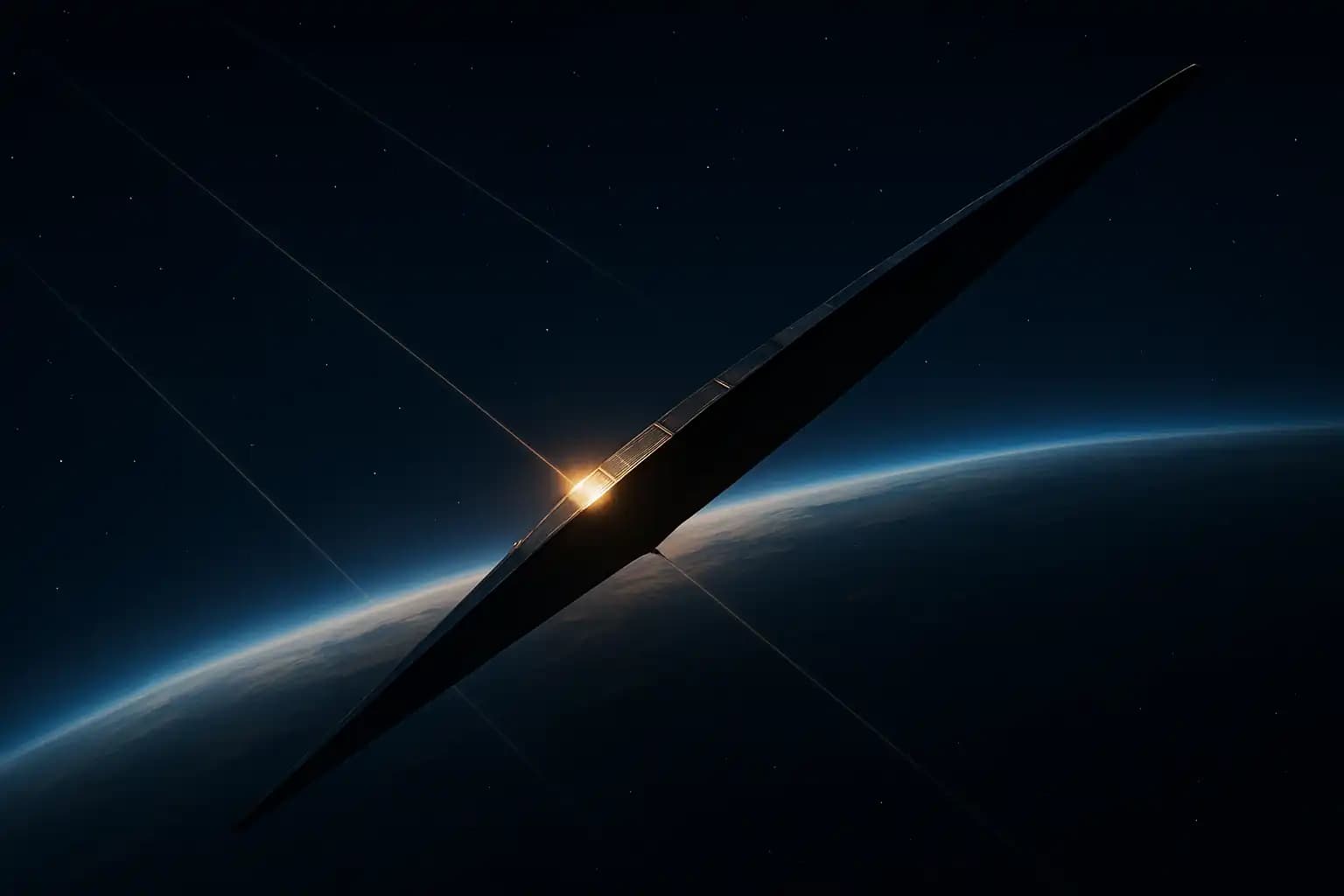The International Astronomical Union’s Minor Planet Center received the alert at 03:17 UTC—a wobbling blip captured by three telescopes on opposite continents. It was too slow to be a rock yet too agile to be a derelict payload. Within hours, observers named it “Little ’Mua,” after 2017’s interstellar enigma ʻOumuamua. While its predecessor slashed through the inner Solar System, this newcomer hugs Earth’s skyline, sliding between GPS satellites and weather sentinels as if it knows the lanes better than mission control.
The object’s light curve does not match known rocket bodies, and spectrographs show odd metallic ratios absent in shuttle-era alloys. No agencies have reported a lost satellite; no conglomerate has whispered about proprietary hardware. This vacuum of ownership fuels speculation among respectable astronomers and late-night podcasts alike: if this object is artificial, whose artifact is it—and why is it parked only 36,000 kilometers from us?
Mysterious Object in Earth Orbit Confounds Astronomers
First data suggests an elongated hull roughly fifty meters long—smaller than ʻOumuamua but large enough for instruments or, more fancifully, passengers. Analysts compare its tumbling signature with NASA’s archived metrics on the original interstellar visitor, available here. Unlike that ice-less wanderer, however, this newcomer appears to nudge its trajectory through micro-accelerations too gentle for chemical thrusters but too precise for random outgassing, hinting at active stabilization.
Harvard astronomer Dana Ibrahim, whose team developed software to flag non-gravitational deviations, states the object “walks like guidance, talks like guidance.” Ibrahim authored the July review dissecting ‘Oumuamua’s hyperbolic anomalies, archived at this investigative link. Her models indicate delta-v bursts measured in centimeters per second—suspiciously tidy numbers for cosmic debris.
Is It a Lost Probe or Space Junk? Tracking the Signature
Military radar arrays from Clear Space Force Station provided the most detailed data, revealing surface panels reflecting L-band frequencies in a glyph-like pattern. Classified briefings mention the Blacksky automated catalog of orbital debris, but no match appears. When journalists asked NORAD for comment, spokespersons deferred to NASA, which referred media to a terse blog post citing “ongoing characterization.”
Public fascination spikes each time Ibrahim’s team releases a fresh ephemeris. Her GitHub repo, linked in midnight tweets, crashed twice under traffic rivaling celebrity scandals. That frenzy recalls doomscroll eruptions traced in this earlier analysis of existential headlines, where data and dread feed each other in real time.
The top Brave search of the object’s cosmic cousin directs curious readers to Wikipedia’s Ōumuamua page, reminding us how quickly a single anomaly can rewrite textbooks—or at least create lucrative speaking circuits.
Lessons from Mini-Moons: The 2024 PT5 Precedent
Veteran orbital-mechanics enthusiasts recall 2024 PT5, the mini-moon that lingered for two months before drifting away, later revealed as a lunar shard. This precedent underscores how tricky it is to distinguish an asteroid from an artifact, or outright myth. Details on PT5’s origin filled science desks worldwide, thanks to a Times of India explainer bookmarked here. Yet PT5 never produced engineered alloys or deliberate course adjustments.
Amateur astronomers contrast those natural quirks with the newcomer’s apparent station-keeping. The discussion evokes parallels with outlier signals recorded in Earth’s electromagnetic cavity, chronicled in this resonance-surge report. Whether strange space rocks or ELF spikes, unexplained phenomena now share rapid scrutiny: social media posts, open-source data sets, and a global hive mind eager to solve—or sensationalize—the riddle.
Echoes of the Black Knight Myth and Modern Analysis
Conspiracy forums quickly labeled the object “Black Knight 2.0,” a reference to the long-standing myth of an alien artifact shadowing Earth. Skeptics direct curious minds to the comprehensive breakdown found here, which attributes the legend to misidentified space debris, Cold War spy tech, and overinterpreted NASA images. Believers argue that myths often bloom from misunderstood truths.
Astro-archaeologists—yes, that’s a thing—note that NASA once mistook Saturn’s hexagon for image noise. Might history repeat? Document troves uncovered in this archaeographic leak show how culture reframes each discovery through ancient lenses. Scientists must walk a tightrope: respect public imagination without derailing evidence-based inquiry.
Security and Economic Stakes of an Artificial Visitor
Beyond cosmic curiosity, orbital uncertainty raises geopolitical concerns. An unregistered satellite—alien or earthly—could collide with billion-dollar assets. Insurance carriers already panic over growing debris fields; a mysterious interloper increases actuarial uncertainty. Analysts modeling worst-case scenarios, like those mapping strategic showdowns in this Pacific scenario, now include the object in simulations. Could a collision disrupt GPS timing and trigger stock-exchange chaos? Yes, warns Blue Mosaic Risk’s latest memo.
On Wall Street, space-mining startups capitalize on the mystery for pitch decks. “If it’s alien hardware, salvage rights could be priceless,” one VC suggests. This pitch mirrors maritime salvage fantasies once fueled by glowing orb sightings off cargo routes, documented here. Legal scholars worry; Outer Space Treaty language on non-appropriation remains ambiguous.
The Race to Identify, Engage, or Ignore
As agencies debate response protocols, the object continues its orbit, its polished facets catching sunrise twice daily like a silent heliograph. Plans range from optical-mesh laser interrogation to a rapid SmallSat rendezvous mission led by Caltech’s Kepler-X team. This mission riffs on a proposal for an ʻOumuamua chaser detailed on NASA TechPort—the top Brave result you will find here—proof that science dreams can sprint from PDF to payload when urgency rises.
Yet not all support intervention. Some advisors remind policymakers of unintended consequences: a probe could misjudge surface texture, crash, and seed new debris, echoing fears of chain reactions examined in this systemic-risk feature. Others argue that inaction poses equal risk; ignorance never prevents collision.
Amid the debate, one fact remains: uncertainty thrives in a vacuum. This is why repositories like Unexplained.co archive every public telemetry ping, academic preprint, and amateur light curve into a single open dataset. Transparency, advocates say, is the only antidote effective whether the intruder proves extraterrestrial, covert hardware, or next-level space junk.
Conclusion: Waiting for Little ’Mua to Speak
As night falls over the Western Hemisphere, observatories angle their mirrors toward the faint dot slipping past Draco. Will tomorrow’s spectra reveal solar sails, micro-thrusters, or just an oddly shaped rock? In the grand ledger of mysteries, this entry remains marked “unresolved,” but each orbital pass brings us closer to an answer. If this is a messenger, its first communiqué is silence, challenging humanity to interpret, investigate, and perhaps confront a broader reality—one where our planetary neighborhood hosts visitors we never invited but can no longer ignore.




